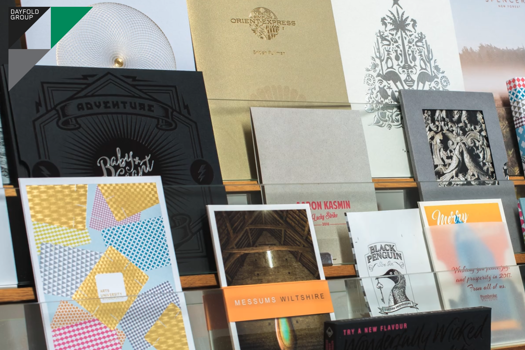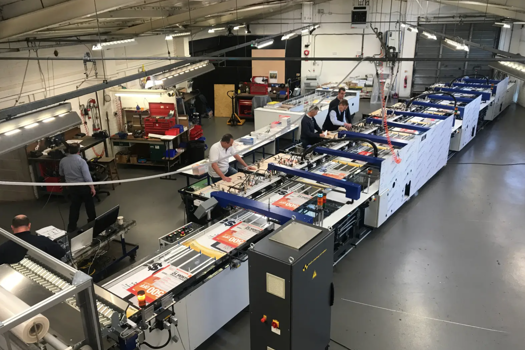This one really did what it said on the box: once built, the owner could use the supplied ink, rubber type characters and a facsimile of a Gutenberg page, then pull the lever-screw to print on small paper sheets.
Aged seven in 1965, my wonderful Christmas present was a second-hand electric train set, with a mix of Tri-ang’s own British engines and some curious designs never seen on British tracks. These were from the US Lionel Corporation, adapted to Tri-ang couplings.
With the train set came an old Tri-ang Lionel catalogue for 1963, full of wonders and inspiration for future birthdays and Christmases. Near the back was a curious section of science toys and ‘Famous Inventors’ kits of technological milestones, with the claim that they actually worked.
Tri-ang, Lionel and Hornby
Since the early 1900s Lionel has been famous in the US for its model train sets and accessories. By the 1940s and 50s it was one of the largest toy companies in the world.
In 1961 Lionel reached a reciprocal deal with UK’s Lines Bros, whose Tri-ang electric model railways competed with the Meccano-owned Hornby range. Tri-ang adapted some Lionel trains and action accessories, while Lionel briefly sold Lines’ Scalextric slot car sets.
At the time Lionel was trying to balance declining sales of model railways with a range of practical science kits, including working weather stations, electronics engineering and DIY plastics moulding sets.
Sold alongside these was the Famous Inventors Series. Although Lionel commissioned the kits, they were made in Lines’ Rovex factory in Margate, alongside Tri-ang trains, so UK versions were sold here too.
The 1963 Tri-ang Lionel catalogue lists nine of them: Gutenberg’s Press, Hooke’s Compound Microscope, Cartwright’s Power Loom, Hero’s Steam Turbine, Morse’s Telegraph, Edison’s Phonograph, Edison’s Electric Light, Galileo’s Telescope and Bell’s Telephone.
Gutenberg’s press took top spot, with a half-page spread showing a boy and a girl enjoying setting the rubber type and inking-up. Showing a girl working with scientific and construction kits was remarkably egalitarian for 1963.
In 1964 Lines took over Meccano with its Hornby railway and Dinky toy car brands. It merged the train ranges, selling them as Tri-ang Hornby for a few years until Lines itself went bust in 1971. It was bought by Combex-Marx, which used just the Hornby name after 1972. A management buyout in 1981 established today’s Hornby Hobbies, which has since acquired other famous UK toy brands, including Airfix in 2007.
Auction opportunity
When I saw a Lionel Gutenberg model come up on eBay earlier this year, I remembered it from that old catalogue I’d thumbed through on rainy afternoons almost 50 years ago. I won it with a bid of £40 plus shipping costs from the US.
The seller listed it as incomplete, but only some of the packing and the bust of Gutenberg were missing. The type and stereo had clearly never been used to print.
I liked it so much that when I saw a complete “mint-in-box” version offered online for £90 in September by a UK model railway shop, I bought that too. The boxes looked so cleverly presented that I wanted to see for myself how they were arranged. This also got me the bronzed plastic bust of Gutenberg, missing in my first model. It’s entirely imaginary, but great for a print enthusiast. The US and UK versions had different addresses and logos on the boxes.
My 1963 catalogue disappeared many years ago in a house move, but I tracked down a replacement a few weeks ago and scanned in the Famous Inventors spread, shown here.
Educational booklet
A 24 page sub-A5 instruction booklet supplied with the model is admirably informative about the history of printing, typesetting and letterpress.
The UK version starts with a foreword by Walter Lines, chairman of Lines Bros. “The experiments you are about to undertake are a valuable ground for developing your scientific abilities,” he wrote.
This is followed by four pages on Gutenberg and his press. It’s solid history, not at all dumbed-down, including theories that Koster of Holland and Castaldi of Italy were printing books before Gutenberg in 1450. It mentions moveable type being used in Korea in the 11th century and name-checks Caxton’s work in London after 1476.
Another two pages trace the growth of printing, including the Times’ first steam-driven powered press (covered by Caroline Archer in the 24 November issue of PrintWeek), the development of mechanical typesetting and the main printing processes of the 1960s, letterpress, offset lithography and photogravure. There’s a full-page reproduction of a page from the Constance Missal, reputed to be Gutenberg’s first printed book.
Instructions for building the press occupy the next eight pages, then there’s a glossary of typographical terms and two pages of proofreaders’ marks, followed by a two-page ad for the other Famous Inventors kits.
Building the kit
When the kit is new, through the clear box lid you see a few of the main parts attached to a cardboard inner tray, with the bronze-coloured plastic bust of Gutenberg perched above them. The two-colour instruction booklet slots in vertically behind Johann.
The instructions take you through the assembly step-by-step, though most of the process is obvious. There are about 39 parts to the press.
It uses metal legs, bed, cross-piece and screw to take the stress of impressions, but these are hidden by a plastic wood-effect shell that looks pretty well like Gutenberg’s actual press. Nuts and clips keep the metal parts together.
All the ‘wooden’ plastic parts are held together with plastic wedges that replicate carpenters’ methods from the 1400s. No glue is needed so the press can be assembled and pulled apart again without damage as often as you like.
The typesetting components include a bag of small rubber letters that you can set using supplied tweezers. You can also print the rubber plate that has a small section of a Gutenberg page, with a large initial character. There’s a small capsule of water-based black ink, plus a rubber roller and a flat plate to roll it on. Finally there’s a small stack of blank paper measuring 70x108mm.
Printing
With the press assembled, it’s time to try it out. The basic principle is authentic, in that type is placed face-up in a sliding tray and inked. A sheet of paper is pressed onto the type and the tray is slid under the pressure platen, with guide pins to align it. The metal screw (technically called the spindle) is rotated clockwise using finger and thumb, although you can use the metal pull-bar for authenticity. This pushes the platen down onto the paper and type, making an impression. After a few seconds you undo the screw, the platen comes up, you slide the tray out and carefully peel off the paper. A print!
For understandable reasons Lionel simplified the design, in that unlike the original press there’s no hinged frame to hold the paper and drop it onto the type forme before making the impression. But otherwise the press and movable type principle is exactly the same as Gutenberg developed. Gutenberg’s other innovation, casting molten lead type in re-usable moulds, 1is not attempted in the model for obvious reasons.
So, what’s the print like? Pretty awful, it has to be said. The original ink had dried up, so rubber stamp ink was used. It was hard to get enough of this onto the type surface and the transfer was pretty uneven. Possibly the half-century old rubber has lost its resilience. But, the press really does print, so it’s worth further experiments with inks and modern rubber stamps.
Display case
After you built your Famous Inventors model, you could take the inner packaging materials out and use the sturdy outer box as a museum-style display case. The clear plastic lid kept the dust off while the foil, black and green base explained what it was. A clever idea that doesn’t quite work as the assembled press is too tall to fit!
The base is gold foiled board, doubled over to form strong sides and overprinted by letterpress with black, white and transparent green ink. That, together with the big clear plastic top, would have been expensive to produce then, as now. But it would certainly have had shelf appeal and 50 years on both the boxes I have look almost new.
The rest of the Lionel Famous Inventors series looks equally well thought out. If they went back on the market today they wouldn’t be dated except for the kids’ hairstyles in the promotional materials. But would today’s kids prefer smartphone apps to getting their hands inky?
SPECIFICATIONS
Max print area 70x65mm
Sheet size 70x108mm
Speed 120sph
Footprint 130x170mm
Scale Approx 1/10th
Weight 410g
Type supplied 135 characters of 12pt serif typeface, in 4 each of upper and lower case letters, plus numbers and punctuation marks
Gutenberg bust height 170mm
Applications Educational construction kit. Will print hand-set rubber type and small rubber/plastic stamps on small sheets of paper
Price In 1963: 45 shillings (£3.75); In 2014: £40 to £90
Contact www.ebay.co.uk
REVIEWER PROFILE
Simon Eccles grew up in a printing family and studied printing management and technology at Manchester Polytechnic in the late 1970s. He briefly worked in the industry before being recruited as a trainee reporter on Printing World in 1981. He is a long-standing contributor to PrintWeek, going back to the days when he was a features editor in 1983-85 when the title was still called LithoWeek.
Why it was bought...
“I’ve been collecting model presses for the past few years, starting with the very simple non-functioning one that the Gutenberg Museum used to sell on its drupa stands,” said Eccles.
“I’ve also come across quite a few model presses on eBay, usually claiming to be replicas of Gutenberg’s original, although a couple are said to be inspired by a doodle by Leonardo da Vinci.
“The Lionel Gutenberg press is the best model press I’ve ever seen and the only one to actually print! I like it so much I’ve bought two of them.”
How it has performed...
It’s no Heidelberg – it’s not even an Adana – but it works and probably will produce decent prints after some further experimenting with rubber stamp materials and inks.
As an educational toy it’s fantastically well designed. The presentation in the packaging is beautiful, it screws and clips together easily, and can be disassembled and reassembled any number of times.
The instruction booklet has some good historical information on Gutenberg and the subsequent development of typesetting and printing up to the present day (of the 1960s).










